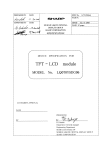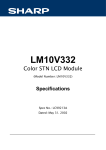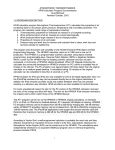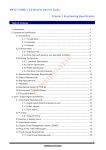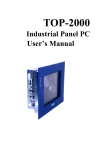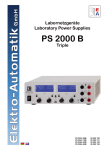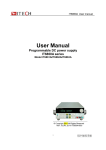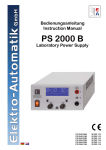Download Sharp R-308CK Specifications
Transcript
Technical Document LCD Specification LCD Group LQ038Q5DR01 LCD Module Product Specification February 2010 QVGA module featuring very wide temperature range and very wide temperature tolerance, along with improved shock and vibration resistance. Brightness is 450 nits with contrast of 100:1. Full Specifications Listing RECORDS OF REVISION LQ038Q5DR01 SPEC No. DATE PAGE SUMMARY NOTE LD-22113 Feb.3.2010 - - 1 st Issue LD-22113-1 NOTICE This publication is the proprietary of SHARP and is copyrighted, with all rights reserved. Under the copyright laws, no part of this publication may be reproduced or transmitted in any form or by any means, electronic or mechanical for any purpose, in whole or in part, without the express written permission of SHARP. Express written permission is also required before any use of this publication may be made by a third party. The application circuit examples in this publication are provided to explain the representative applications of SHARP's devices and are not intended to guarantee any circuit design or permit any industrial property right or other rights to be executed. SHARP takes no responsibility for any problems related to any industrial property right or a third party resulting from the use of SHARP's devices, except for those resulting directly from device manufacturing processes. In the absence of confirmation by device specification sheets, SHARP takes no responsibility for any defects that occur in equipment using any of SHARP's devices, shown in catalogs, data books, etc. Contact SHARP in order to obtain the latest device specification sheets before using any SHARP's device. SHARP reserves the right to make changes in the specifications, characteristics, data, materials, structures and other contents described herein at any time without notice in order to improve design or reliability. Contact SHARP in order to obtain the latest specification sheets before using any SHARP's device. Manufacturing locations are also subject to change without notice. Observe the following points when using any device in this publication. SHARP takes no responsibility for damage caused by improper use of the devices. The devices in this publication are designed for use in general electronic equipment designs, such as: ・Personal computers ・Office automation ・Telecommunication equipment ・Test and measurement equipment ・Industrial control ・Personal Digital Assistant ・Audio visual and multimedia equipment ・Consumer electronics The appropriate design measures should be taken to ensure reliability and safety when SHARP's devices are used for equipment such as: ・Transportation control and safety equipment(i.e. aircraft, trains, automobiles, etc.) ・Traffic signals ・Gas leakage sensor breakers ・Alarm equipment ・Various safety devices etc. SHARP's devices shall not be used for equipment that requires extremely high level of reliability, such as: ・Military and space applications ・Nuclear power control equipment ・Medical equipment for life support Cold cathode fluorcent lamp in devices contains a small amount of mercury. Please follow local ordinances or regulations for disposal. Contact a SHARP representative, in advance, when intending to use SHARP's devices for any "specific" applications other than those recommended by SHARP. Contact and consult with a SHARP representative if there are any questions about the contents of this publication. LD-22113-2 (1) Application This specification literature applies to color TFT-LCD module ,LQ038Q5DR01. (2) Summary And Features This module is a color active matrix LCD module incorporating amorphous silicon TFT (Thin Film Transistor). It is composed of a color TFT-LCD panel, driver ICs, control-PWB, FPC, frame, front shielding case, back-light unit. Graphics and texts can be displayed on a 320×3×240 dots panel with 262,144 colors by supplying. DC/AC inverter isn’t composed. The 3.8 screen produces a high resolution image that is composed of 76,800 pixel elements in a stripe arrangement. Wide viewing angle technology is employed. (The most suitable viewing angle is in the 6 o'clock direction.) By adopting an active matrix drive, a picture with high contrast is realized. Through the use of TN-normally white mode, an image with highly natural color image is realized. An inverted video display in the vertical and horizontal directions is possible. This module is adapted to RoHS compliance. (3)Mechanical Specifications Parameter Display format Active area Screen size (Diagonal) Dot pitch Pixel configuration Outline dimension Mass 【Note 3-1】 Typical values are given. table 3-1 Specifications 76,800 320(W) × RGB × 240(H) 78.72(W)× 53.64(H) 9.6 [3.8”] 0.082(W)× 0.2235(H) R,G,B Stripe configuration 117.6(W)×69.45(H)×13.45(D) Max.135 Units pixels dots mm cm mm mm g Remarks 【Note3-1】 For detailed measurements and tolerances, please refer to Fig. 1. LD-22113-3 (4) Input Terminal 4-1) TFT-LCD Panel Driving Part Used connector: KX14-40K5D-VIE (JAE Co. , Ltd) Fit connector Pin No. 1 2 3 4 5 6 7 8 9 10 11 12 13 14 15 16 17 18 19 20 21 22 23 24 25 26 27 28 29 30 31 32 33 34 35 36 37 38 39 40 Symbol GND VCC Hsync G3 T0 G4 T1 G5 HVR GND GND B0 CLK B1 GND B2 R0 GND R1 B3 R2 B4 GND B5 R3 GND R4 Vsync R5 TEST GND TEST G0 TEST G1 TEST G2 ENAB VCC GND : KX15-40KLDLE(JAE Co. , Ltd) Table 4-1 CN1 Description ground Power supply voltage Horizontal synchronous signal GREEN data signal thermistor output1 GREEN data signal thermistor output2 GREEN data signal(MSB) Selection for horizontal and vertical scanning direction ground ground BLUE data signal(LSB) Clock signal for sampling each data signal BLUE data signal ground BLUE data signal RED data signal(LSB) ground RED data signal BLUE data signal RED data signal BLUE data signal ground BLUE data signal(MSB) RED data signal ground RED data signal Vertical synchronous signal RED data signal(MSB) Open use only Ground Open use only GREEN data signal(LSB) Open use only GREEN data signal Open use only GREEN data signal Signal to settle the horizontal display position Power supply voltage ground Remarks 【Note4-1】 【Note4-3】 【Note4-1】 【Note4-2】 LD-22113-4 【Note 4-1】 Hsync positive Vsync positive 【Note 4-2】 The horizontal display start timing is settled in accordance with a rising timing of ENAB signal. In case ENAB is fixed “Low”, the horizontal start timing is determined as described in Fig3-A. (Don’t keep ENAB “High” during operation.(Fig3-B).) 【Note 4-3】 HVR = "Low" : Regular video HVR = "High" : Horizontally and Vertically inverted video 【Note 4-4】 The position of pin number 40 38 36 34 32 30 28 26 24 22 20 18 16 14 12 10 8 6 4 2 39 37 35 33 31 29 27 25 23 21 19 17 15 13 11 9 7 5 3 1 4-2) Back-light fluorescent tube driving part Used connector:BHR-02(8.0)VS-1N(JST Co. ,Ltd) Fit connctor:SM02(8.0)B-BHS-1N(JST Co. ,Ltd) Table 4-2 CN2 No. Symbol i/o Function Color of FL cable 1 VL1 I input terminal (High Voltage) RED 2 VL2 I input terminal (Low Voltage) WHITE Caution:Please use this thermistor in order to check the lamp temperature. Model number of Thermistor:203GT−1 (made by Ishizuka electoronics Corporation) Zero load resistance value at 25℃:20.0kΩ±3% (5)Absolute maximum ratings Parameter Input voltage Symbol Table 5-1 Min. Max. Unit VI −0.3 VCC+0.3 V GND=0V Note 【Note 5-1】 Ta=25℃ Ta=25℃ 【Note 5-2】 V +3.3V power supply VCC 0 5.5 Tstg −40 ℃ Storage temperature +95 Operating temperature Topr1 −30 ℃ 【Note 5-2】 +85 (panel surface) Operating temperature Topr2 −30 ℃ 【Note 5-2】 +60 ( Ambient temperature ) 【Note 5-1】 CK,R0∼R5,G0∼G5,B0∼B5,Hsync,Vsync,ENAB,HVR 【Note 5-2】 Humidity:95%RH Max. at Ta≦60℃ Maximum wet-bulb temperature is less than 58℃. at Ta>60℃. Condensation of dew must be avoided as electrical current leaks will occur, Causing a degradation of performance specifications. LD-22113-5 (6)Electrical characteristics 6-1)TFT-LCD panel driving section Parameter Supply voltage +3.3V Current dissipation Permissive input ripple Input Low voltage Input High voltage Table 6-1 Symbol Min. Vcc +2.9 − I cc − VRF − VIL VIH 0.7VCC GND=0V,Ta=25℃ Max. Unit Remarks +3.7 V 【Note 6-1】 180 mA 【Note 6-2,3】 100 mVpp 0.3VCC V 【Note 6-4】 − V VI=0V 1.0 µA 【Note 6-5】 VI=VCC 75 µA 【Note 6-5】 VI=0V 75 µA 【Note 6-6】 VI=VCC 1.0 µA 【Note 6-6】 VI=0V 150 µA 【Note 6-7】 VI=VCC 2.0 µA 【Note 6-7】 Typ. +3.3 140 − − − Input current (Low) IIL − − Input current (High) IIH 3.0 − Input current (Low) IIL 3.0 − Input current (High) IIH − − Input current (Low) IIL 6.0 − Input current (High) IIH − − Vcc 2.8V 2.8V data data 0.3V 0.3V t3 t4 t2 Vcc Vcc-dip conditions 2) 2.8V≦Vcc<2.9V td≦10ms Vcc<2.8V Vcc-dip conditions should also follow the on-off conditions. V 8 . 2 1) td Black(GS0) 【Note 6-2】 Typical current situation: Black (GS0) pattern Timing: Typical VCC= +3.3 V 【Note 6-3】Maximum current situation: Vertical stripe pattern alternating 21 gray scale (GS21) with 42 gray scale (GS42) every 1 dot. Timing; Typical VCC= +3.3 V t1 GS21 GS42 V 9 . 2 【Note 6-1】 On-off conditions for supply voltage 0<t1≦10ms 0<t2≦10ms 0<t3≦1s t4≧1s LD-22113-6 【Note 6-4】CK,R0∼R5,G0∼G5,B0∼B5,Hsync,Vsync,ENAB,HVR 【Note 6-5】CK,R0∼R5,G0∼G5,B0∼B5,Hsync,Vsync 【Note 6-6】ENAB 【Note 6-7】HVR 6-2)Backlight driving section The backlight system is an edge-lighting type with single CCFT (Cold Cathode Fluorescent Tube). The characteristics of Lamp are shown in the following table. Table 6-2 Parameter Symbol Min. Typ. Max. Unit Remarks IL=5.5mArms lamp voltage VL7 470 530 590 Vrms lamp current IL 5.0 5.5 6.0 mArms ordinary state PWM dimming state − − ILB 9.0 mArms 【Note 6-8】 − 【Note 6-9】 lamp frequency fL 30 60 kHz − − Ta=+25℃ kick-off voltage 1650 Vrms 【Note 6-10】 VS − − Ta=−30℃ 1700 Vrms Inverter:HIU-288 [Harison Toshiba Lighting Corp.] (Output capasitor:22pF,frequency:49kHz) 【Note 6-8】available area Dimming 100% 80% Available area 9.0% 3.5% -30℃ 25℃ 50℃ Temperature Please turn on the lamp with symmetrical (negative and positive) voltage and current wave form. Don’t use the unsymmetrical voltage and current wave which have spike wave. 【Note 6-9】Lamp frequency may produce interference with horizontal synchronous frequency, and this may cause beat on the display. Therefore lamp frequency shall be detached as much as possible from the horizontal synchronous frequency and from the harmonics of horizontal synchronous to avoid interference. 【Note 6-10】The open output voltage of the inverter shall be maintained for more than 1s; otherwise the lamp may not be turned on. LD-22113-7 7) Timing Characteristics of input signals Timing diagrams of input signal are shown in Fig.3-A, Fig.3-B. 7-1) Timing characteristics Table 7-1 Parameter Symbol MIN TYP MAX Unit Remarks Clock frequency 1/Tc 4.5 6.3 6.8 MHz High time Tch 50 ns − − Low time Tcl 50 ns − − Data Setup time Tds 50 ns − − Hold time Tdh 50 ns − − Hsync-Clock phase difference THc 50 120 ns − Hsync-Vsync phase difference TVh 0 TH-10 µs − Note) In case of lower frequency, the deterioration of display quality, flicker etc., may be occurred. 7-2) Horizontal display position ①In case ENAB is active The horizontal display position is determined by ENAB signal and the input data corresponding to the rising edge of ENAB signal is displayed at the left end of the active area. (shown in Fig.3-A.) Parameter symbol Min. Typ. Max. Unit Remark Horizontal 50 63.5 80 µs Cycle TH sync. signal THe+308 400 440 clock Pulse width THp 4 12 30 clock − Tc−10 Enable signal Setup time Tes 50 ns Pulse width Tep 320 clock Hsync-Enable signal phase − THe 14 72 clock difference Horizontal display period THd 320 320 320 clock ②In Case ENAB is “Low” . (shown in Fig.3-B) Parameter symbol Min. Horizontal 56 Cycle TH sync. signal 380 Pulse width THp 4 Hsync-data signal phase THe 72 difference Horizontal display period THd 320 Typ. 63.5 400 12 Max. 80 440 30 Unit µs clock clock 72 72 clock 320 320 clock Max. 330 − 6 240 Unit line line line line 7-3) Vertical Display Position Parameter Symbol Min. Typ. Vertical sync. Cycle TV 246 263 signal − Pulse width TVp 1 Vertical display start position TVs 6 6 Vertical display period TVd 240 240 ENAB signal has no relation to the vertical display position. Remark Remarks LD-22113-8 7-4) Input Data Signals And Display Position on The Screen UP D1,DH1 D2,DH1 D1,DH2 D2,DH2 D3,DH1 D320,DH1 D1,DH3 R G B D1,DH240 D320,DH240 Display position of input data (H,V) LD-22113-9 (8) Input Signals, Basic Display Color And Gray Scale of Each Color Data signal Colors & Gray scale Gray Scale R0 R1 R2 R3 R4 R5 G0 G1 G2 G3 G4 G5 B0 B1 B2 B3 B4 B5 Basic color Gray Scale of red Gray Scale of green Gray Scale of blue Black − 0 0 0 0 0 0 0 0 0 0 0 0 0 0 0 0 0 0 Blue − 0 0 0 0 0 0 0 0 0 0 0 0 1 1 1 1 1 1 Green − 0 0 0 0 0 0 1 1 1 1 1 1 0 0 0 0 0 0 Cyan − 0 0 0 0 0 0 1 1 1 1 1 1 1 1 1 1 1 1 Red − 1 1 1 1 1 1 0 0 0 0 0 0 0 0 0 0 0 0 Magenta − 1 1 1 1 1 1 0 0 0 0 0 0 1 1 1 1 1 1 Yellow − 1 1 1 1 1 1 1 1 1 1 1 1 0 0 0 0 0 0 White − 1 1 1 1 1 1 1 1 1 1 1 1 1 1 1 1 1 1 Black GS0 0 0 0 0 0 0 0 0 0 0 0 0 0 0 0 0 0 0 × GS1 1 0 0 0 0 0 0 0 0 0 0 0 0 0 0 0 0 0 Darker GS2 0 1 0 0 0 0 0 0 0 0 0 0 0 0 0 0 0 0 × È È È È Ø È È È È Brighter GS61 1 0 1 1 1 1 0 0 0 0 0 0 0 0 0 0 0 0 Ø GS62 0 1 1 1 1 1 0 0 0 0 0 0 0 0 0 0 0 0 Red GS63 1 1 1 1 1 1 0 0 0 0 0 0 0 0 0 0 0 0 Black GS0 0 0 0 0 0 0 0 0 0 0 0 0 0 0 0 0 0 0 × GS1 0 0 0 0 0 0 1 0 0 0 0 0 0 0 0 0 0 0 Darker GS2 0 0 0 0 0 0 0 1 0 0 0 0 0 0 0 0 0 0 × È È È È Ø È È È È Brighter GS61 0 0 0 0 0 0 1 0 1 1 1 1 0 0 0 0 0 0 Ø GS62 0 0 0 0 0 0 0 1 1 1 1 1 0 0 0 0 0 0 Green GS63 0 0 0 0 0 0 1 1 1 1 1 1 0 0 0 0 0 0 Black GS0 0 0 0 0 0 0 0 0 0 0 0 0 0 0 0 0 0 0 × GS1 0 0 0 0 0 0 0 0 0 0 0 0 1 0 0 0 0 0 Darker GS2 0 0 0 0 0 0 0 0 0 0 0 0 0 1 0 0 0 0 × È È È È Ø È È È È Brighter GS61 0 0 0 0 0 0 0 0 0 0 0 0 1 0 1 1 1 1 Ø GS62 0 0 0 0 0 0 0 0 0 0 0 0 0 1 1 1 1 1 Blue GS63 0 0 0 0 0 0 0 0 0 0 0 0 1 1 1 1 1 1 0 :Low level voltage 1 :High level voltage Each basic color can be displayed in 64 gray scales from 6 bit data signals. According to the combination of total 18 bit data signals, the 262,144-color display can be achieved on the screen. LD-22113-10 (9)Optical Characteristics Table 9-1 Ta=+25℃, VCC=+3.3V Symbol Condition Min. Typ. Max. Unit Remarks θ6 − 60 65 degree 【Note 9-1,4】 θ12 − 35 40 degree CR≧5 θ3 − 60 65 degree θ9 − − 【Note 9-2,4】 Contrast ratio CRmax Optimum 100 τr θ=0° − 【Note 9-3,4】 Response Rise 30 60 ms τd − time Fall 50 100 ms − 【Note 9-5】 Luminance Y IL=5.5mArms 350 450 cd/m2 【Note 9-5】 White chromaticity x 0.263 0.313 0.363 IL=5.5mArms y 0.279 0.329 0.379 +25℃ − − − 【Note 9-6】 Lamp life time continuation 20,000 hour − − − 【Note 9-7】 (Reference value) −30℃ intermission 2,000 times DC/AC inverter for external connection shown in following. Inverter:HIU-288 [Harison Tosihba Lighting Corp.] (Output capasitor:22pF,frequency:49kHz) ※measuring after 30minutes Parameter Viewing angle range Photodetector Response Time(BM-5A) Contrast ratio/Luminance/ Chromaticity(SR-3) Photodetector(EZ-CONTRAST) 400mm Field=1° Center of screen(θ=0°) Center of screen(θ=0°) TFT-LCD-Module TFT-LCD-Module Fig.9-1) Viewing Angle Measurement Method Fig.9-2) Luminance / Contrast ratio / Response time Chromaticity Measurement Method Fig.9 Optical Characteristics Measurement Method LD-22113-11 【Note 9-1】 Viewing angle range is defined as follows. Normal line θ92 θ θθ6 11 θ 12 θθ3 2 6 o’clock direction Definition for Viewing Angle 【Note 9-2】Contrast ratio is defined as follows: Photo detector output with LCD being "white" Contrast ratio(CR)= Photo detector output with LCD being "black" 【Note 9-3】Response time is obtained by measuring the transition time of photo detector output, when input signals are applied so as to make the area "black" to and from "white". White Black White 100% 90% t u p t u o r e t c e t e d o t o h P ) t i n u y r a r t i b r a ( 10% 0% τr τd Time 【Note 9-4】Measured on the center area of the panel at a viewing cone 2°(= Filed) by TOPCON luminance meter BM-5A, SR-3 or ELDIM luminance meter EZ Contrast. (After 30 minutes operation) DC/AC inverter driving frequency:( 49 kHz) 【Note 9-5】Measured on the center area of the panel at a viewing cone 1°(= Filed) by TOPCON luminance meter BM-5A, SR-3.(After 30 minutes operation) DC/AC inverter driving frequency:( 49 kHz) LD-22113-12 【Note 9-6】Lamp is consumables. In the following condition, the lamp life time is 20,000 hours as the reference value and it is not guaranteed in this specification sheet by SHARP. Lamp life time is defined that it applied either ① or ② under this condition. ※Continuous turning on at Ta = 25 oC, IL = 5.5mA rms and PWM dimming 80%~5% (IL= 9.0mArms Ta= 25℃). ①Brightness becomes 50% of the original value under standard condition. ②Kick-off voltage at Ta = −30 oC exceeds maximum value (1700Vrms). Lamp life time shortens according to the state of mounting and use. In case of operating under lower temp environment, the lamp exhaustion is accelerated and the brightness becomes lower. Continuous operating for around 1 month under lower temp condition may reduce the brightness to half of the original brightness. In case of such usage under lower temp environment, periodical lamp exchange is recommended. 【Note 9-7】The intermittent cycles is defined as a time when brightness not to become under 50% of the original value under the condition of following cycle. Ambient temperature:−30℃ HIGH(9mArms) OFF 5min 5min 5min 5min Don’t use the unsymmetrical voltage and current wave which have spike wave. 【Note 9-8】The performance of the backlight, for example life time or brightness, is much influenced by the characteristics of the DC-AC inverter for the lamp. When you design or order the inverter, please make sure that a poor lighting caused by the mismatch of the backlight and the inverter (miss-lighting,flicker, etc.) never occur. when you confirm it, the module should be operated in the same condition as it is installed in your instrument. Be sure to use a back light power supply with the safety protection circuit such as the detection circuit for the excess voltage, excess current and or electric discharge waveform. 【Note 9-9】Please make it to the structure not touching directly insulating the high voltage part. Please stop the circuit by the protection element such as fuses for generation of heat and the ignition prevention, and use a flame resisting and high material for the substrate and the resin material. 【Note 9-10】Under the environment of 10lx or less, miss-lighting delay may occur. LD-22113-13 (10) Mechanical Characteristics 10-1) External Appearance Do not exist extreme defects. (See Fig. 1) 10-2) Panel Toughness The panel shall not be broken ,when 19N is pressed on the center of the panel by a smooth sphere having 15 mm diameter. Caution:In spite of very soft toughness, if, in the long-term, add pressure on the active area, it is possible to occur the functional damage. 10-3) Input / Output Connector Performance I/O connector of backlight driving circuit 【JST】 Lump connector Symbol Used Connector Corresponding Connector CN BHR-02(8.0)VS-1N SM02(8.0)B-BHS-1N(assembled on PWB) A, B SM02(8.0)B-BHS-TB(assembled on PWB) BHMR-03V (interconnecter) (11) Display Quality The display quality of the color TFT-LCD module shall be in compliance with the Incoming Inspection Standards for TFT-LCD. (12) Handling Instructions 12-1) Mounting of Module ① The TFT-LCD module is designed to be mounted on equipment using the mounting tabs in the four corners of the module at the rear side. Connect GND to these mounting tabs to stabilize against EMI and external noise. On mounting the module, as the M2.6 tapping screw fastening torque is 0.3 through 0.5N・m is recommended, be sure to fix the module on the same plane, taking care not to wrap or twist the module. Don't reach the pressure of touch-switches of the set side to a module directly, because images may be disturbed. ② Please power off the module when you connect the input/output connector. ③ Please connect the metallic shielding cases of the module and the ground pattern of the inverter circuit surely. If that connection is not perfect, there may be a possibility that the following problems happen. a). The noise from the backlight unit will increase. b). The output from inverter circuit will be unstable. Then, there may be a possibility that some problems happen. c). In some cases, a part of module will heat. d).Please taking care to pull back-light’s cable, when you connect the back-light cable’s connector. LD-22113-14 12-2) Precautions in Mounting Polarizer which is made of soft material and susceptible to flaw must be handled carefully. Protective film (Laminator) is applied on the surface to protect it against scratches and dirties. It is recommended to peel off the laminator immediately before the use, taking care of static electricity. Precautions in peeling off the laminator A) Working Environment When the laminator is peeled off, static electricity may cause dust to stick to the polarizer surface. To avoid this, the following working environment is desirable. a) Floor:Conductive treatment of 1MΩ or more on the tile (conductive mat or conductive paint on the tile) b) Clean room free form dust and with an adhesive mat on the doorway. c) Advisable humidity:50%∼70% Advisable temperature:15℃∼27℃ d) Workers shall wear conductive shoes, conductive work clothes, conductive gloves and an earth band. B) Working Procedures a) Direct the wind of discharging blower somewhat downward to ensure that module is blown sufficiently. Keep the distance between module and discharging blower within 20 cm. b) Attach adhesive tape to the laminator part near discharging blower so as to protect polarizer against flaw. c) Peel off laminator, pulling adhesive tape slowly to your side taking 5 or more second. d) On peeling off the laminator, pass the module to the next work process to prevent the module to get dust. e) Method of removing dust from polarizer ・ Blow off dust with N2 blower for which static electricity preventive measure has been taken. ・ Since polarizer is vulnerable, wiping should be avoided. Direction of wind of blower discharging blower less than 20cm module Adhesive tape backlight cable C) How the remove dust on the polarizer a) Blow out dust by the use of an N2 blower with antistatic measures taken. Use of an ionized air Gun is recommendable. b) When the panel surface is soiled, wipe it with soft cloth. D) In the case of the module’s metal part (shield case) is stained, wipe it with a piece of dry, soft cloth. If rather difficult, give a breath on the metal part to clean better. LD-22113-15 E) If water dropped, etc. remains stuck on the polarizer for a long time, it is apt to get discolored or cause stains. Wipe it immediately. F) As a glass substrate is used for the TFT-LCD panel, if it is dropped on the floor or hit by something hard, it may be broken or chipped off. G) Since CMOS LSI is used in this module, take care of static electricity and take the human earth into consideration when handling. 12-3) Precautions in Adjusting module Adjusting volumes on the rear face of the module have been set optimally before shipment. Therefore, do not change any adjusted values. If adjusted values are changed, the specifications described here may not be satisfied. 12-4) Caution of Product Design The LCD module shall be protected against water salt-water by the waterproof cover. Please take measures to interferential radiation from module, to do not interfere surrounding appliances. The polarizer surface on the panel is treated with Anti-Glare for low reflection. In case of attaching protective board over the LCD, be careful about the optical interface fringe etc. which degrades display quality. 12-5) Others A) Do not expose the LCD panel to direct sunlight. Lightproof shade etc. should be attached when LCD panel is used under such environment. The panel characteristic might be deteriorated and the display fineness decrease when strong light is irradiated to the liquid crystal panel. B) There are high voltage portions on the backlight and very dangerous. Careless touch may lead to electrical shock. When exchange lamps or service, turn off the power without tail. C) Cold cathode fluorescent lamp in LCD panel contains a small amount of mercury, please follow local ordinances or regulations for disposal. D) Be careful of a back light lead not to pull by force at the time of the wiring to an inverter, or line processing. E) The lamp used for this product is very sensitive to the temperature. Luminance decreases rapidly when it is used for a long time or repeatedly under the environment of the low temperature or the module is being cooled. Please avoid the continuous or repeating use of it under such an environment. It may decrease up to 50% of the initial luminance in about one month under the low temperature environment. Please consult our company when it is used under the environment like the above mentioned. F) If stored at temperatures below the rated values, the inner liquid crystal may freeze, causing cell destruction. At temperatures exceeding the rated values for storage, the liquid crystal may become isotropic liquid, making it no longer possible to come back to its original state in some cases. G) If the LCD is broken, do not drink liquid crystal in the mouth. If the liquid crystal adheres to a hand or foot or to clothes, immediately cleanse it with soap. H) If a water drop or dust adheres to the polarizer, it is apt to cause deterioration. Wipe it immediately. I) Be sure to observe other caution items for ordinary electronic parts and components. J) When handling LCD modules and assembling them into cabinets, that long-terms storage in the environment of oxidization or deoxidization gas and the use of such materials as reagent, LD-22113-16 solvent, adhesive, resin, etc. which generate these gasses, causes corrosion and discoloration of the modules. Therefore, please avoid these use. Epoxy resin (amino series curing agent), silicone adhesive material (dealcoholization series and oxime series), Tray forming agent (azo compound) etc, in the cabinet or the packing materials may induce abnormal display with polarizer film deterioration. Be sure to confirm the component of them. K) In case of attaching protective board (or tatch-panel, etc) over the LCD, be careful about the optical interface fringe etc. which degrades display quality. L) The LED used for thes product is very sensitive to the temperature. Luminance decreases rapidly when it issued for a long time under the environment of the high temperature. Please consult our company when it is used under the environment like the above mentioned. M) Please be careful that you don’t keep the screen displayed fixed pattern image for a long time, since retention may occur. N) Disassembling the module can cause permanent damage and you should be strictly avoided. Please don’t remove the fixed tape, insulating tape etc that was pasted on the original module.(Except for protection film of the panel.) O) If a minute particle enters in the module and adheres to an optical material, it may cause display non-uniformity issue, etc. Therefore, fine-pitch filters have to be installed to cooling and inhalation hole if you intend to install a fan. P) VCOM value have been set optimally before shipment, so do not change any adjusted value. If adjusted value is changed, the specification may not be satisfied. Q) Be sure to use a power supply with the safety protection circuit such as the fuse for the excess voltage, excess current and or electric discharge waveform. R) If you pressed down a liquid crystal display screen with your finger and so on, the alignment disorder of liquid crystal will occur. And then It will become display fault. Therefore, be careful not to touch the screen directly, and to consider not stressing to it. S) If any problem arises regarding the items mentioned in this specification sheet or otherwise, it should be discussed and settled mutually in a good faith for remedy and/or improvement. (13) Packing Form (shown in Fig.4.) Piling number of cartons :MAX 10 Package quantity in one carton :50 pcs Carton size :503 (W)×166 (H)×338 (D) mm Total mass of one carton filled with full modules :MAX. 7.5kg Conditions for storage. Environment ①Temperature :0∼40℃ ②Humidity :60%RH or less (at 40℃) No dew condensation at low temperature and high humidity. ③Atmosphere :Harmful gas, such as acid or alkali which bites electronic components and/or wires, must not be detected. ④Direct sunshine :Please keep it in the state of wrapping or the darkroom so that direct sunshine should not strike directly into the product. ⑤Asking for be dewy prevention ・Please do not put directly on the floor, and keep the wrapping box on the palette or the stand to avoid the be dewy. Moreover, please arrange it in a constant direction correctly to improve ventilation under the palette. ・Please separate from the wall in the storage warehouse and keep it. LD-22113-17 ・Please note that ventilation is improved and consider the installation such as ventilators in the warehouse. ・ Please manage so that there is no rapid temperature change more than natural environment. ⑥Period :about 3 months ⑦Opening of the package:In order to prevent the LCD module from breakdown electrostatic charges, please control the room humidity over 50%RH and open the package taking sufficient countermeasures against electrostatic charges, such as earth, etc. (14) Reliability Test Reliability test conditions for the TFT-LCD module are shown in Table 14. (15) Indication of Lot Number ①Attached location of the label:See Fig. 1 ②Indicated contents of the label LQ038Q5DR01 M ○○○○○○○○ model No. lot No. Contents of lot No. the 1st figure ‥ production year ( ex. 2010 : 0 ) the 2nd figure ‥ production month 1,2,3,‥‥‥,9,X,Y,Z the 3rd∼8th figure ‥ serial No. 000001∼ the 9th figure ‥ revision marks A,B,C‥ LD-22113-18 Reliability Test Conditions for TFT-LCD Module Table 14 Remark) Temperature condition is based on operating temperature conditions on (5)-Table 5-1. No. Test items Test Conditions 240h 1 High temperature storage test Ta= +95℃ 240h 2 Low temperature storage test Ta= −40℃ High temperature and 240h 3 Tp= +60℃ , 95%RH high humidity operating test 240h 4 High temperature operating test Tp= +85℃ 240h 5 Low temperature operating test Ta= −30℃ 6 Electro static discharge test ±200V・200pF(0Ω) 1 time for each terminals 2 7 Shock test 980m/s ・6ms, ±X;±Y;±Z 3 times for each direction (JIS C0041, A-7 Condition C) 8 Vibration test Frequency range:8∼33.3Hz Stroke:1.3mm Sweep:33.3Hz∼400Hz Acceleration:28.4m/s2 Cycle:15 minutes X,Z 2 hours for each directions, 4 hours for Y direction (total 8 hours) 【caution】(JIS D1601) 9 Heat shock test Ta= −40℃∼+95℃ / 200 cycles (0.5h) (0.5h) 【Note】Ta= Ambient temperature, Tp= Panel temperature 【Check items】In the standard condition, there shall be no practical problems that may affect the display function. 【caution】X,Y,Z directions are shown as follows: Z X Y LCY00044−17 LD-22113-19 LCY00044−18 LD-22113-20 Fig.2. Structure of the module TH:(THe+308)CK∼440CK C C V 7 . 0 C C V 7 . 0 C C V 3 . 0 C C V 3 . 0 Horizontal sync. signal THp (Hsync) TH T 0.5VCC Number of clock Data signal (R0∼R5,G0∼G5, B0∼B5) 0.5VCC C C V 3 . 0 C C V 3 . 0 C C V 3 . 0 Clock signal (CK) Tc Tch Tcl THc Horizontal invalid data period D1 D2 THe Tds Tdh D3 Number of H-data D319 D320 Horizontal invalid data period THd C C V 7 . 0 C C V 3 . 0 Tes Data enable signal (ENAB) Tep TV C C V 7 . 0 TVp C C V 7 . 0 Horizontal sync. signal (Hsync) C C V 3 . 0 (Vsync) C C V 7 . 0 Vertical sync. signal TVs Data signal (R0∼R5,G0∼G5, B0∼B5) TVd Vertical invalid data DH1 DH2 DH3 Number of line DH239 DH240 Vertical invalid data period Number of V-data line LD-22113-21 Fig3-A) Input Signal Waveform TH:380CK∼440CK C C V 7 . 0 C C V 7 . 0 C C V 3 . 0 C C V 3 . 0 Horizontal sync. signal THp (Hsync) TH T 0.5VCC Tds Tdh Data signal (R0∼R5,G0∼G5, B0∼B5) 0.5VCC C C V 3 . 0 K C 2 7 C C V 3 . 0 C C V 3 . 0 Clock signal (CK) Tc Tch Tcl THc Horizontal invalid data period D1 D2 Number of H-data Number of clock D3 D319 D320 Horizontal invalid data period THd Data enable signal (ENAB) TV C C V 7 . 0 TVp C C V 7 . 0 Horizontal sync. signal (Hsync) C C V 3 . 0 (Vsync) C C V 7 . 0 Vertical sync. signal TVs Data signal (R0∼R5,G0∼G5, B0∼B5) Vertical invalid data TVd DH1 DH2 DH3 Number of line DH239 DH240 Vertical invalid data period Number of V-data line LD-22113-22 Fig3-B) Input Signal Waveform LD-22113-23 LCY00044-21 Fig.4.Packing form Technical Document LCD Specification LCD Group NORTH AMERICA Sharp Microelectronics of the Americas 5700 NW Pacific Rim Blvd. Camas, WA 98607, U.S.A. Phone: (1) 360-834-2500 Fax: (1) 360-834-8903 www.sharpsma.com TAIWAN Sharp Electronic Components (Taiwan) Corporation 8F-A, No. 16, Sec. 4, Nanking E. Rd. Taipei, Taiwan, Republic of China Phone: (886) 2-2577-7341 Fax: (886) 2-2577-7326/2-2577-7328 CHINA Sharp Microelectronics of China (Shanghai) Co., Ltd. 28 Xin Jin Qiao Road King Tower 16F Pudong Shanghai, 201206 P.R. China Phone: (86) 21-5854-7710/21-5834-6056 Fax: (86) 21-5854-4340/21-5834-6057 Head Office: No. 360, Bashen Road, Xin Development Bldg. 22 Waigaoqiao Free Trade Zone Shanghai 200131 P.R. China Email: [email protected] EUROPE Sharp Microelectronics Europe Division of Sharp Electronics (Europe) GmbH Sonninstrasse 3 20097 Hamburg, Germany Phone: (49) 40-2376-2286 Fax: (49) 40-2376-2232 www.sharpsme.com JAPAN Sharp Corporation Electronic Components & Devices 22-22 Nagaike-cho, Abeno-Ku Osaka 545-8522, Japan Phone: (81) 6-6621-1221 Fax: (81) 6117-725300/6117-725301 www.sharp-world.com SINGAPORE Sharp Electronics (Singapore) PTE., Ltd. 438A, Alexandra Road, #05-01/02 Alexandra Technopark, Singapore 119967 Phone: (65) 271-3566 Fax: (65) 271-3855 HONG KONG Sharp-Roxy (Hong Kong) Ltd. Level 26, Tower 1, Kowloon Commerce Centre, No. 51, Kwai Cheong Road, Kwai Chung, New Territories, Hong Kong Phone: (852) 28229311 Fax: (852) 28660779 www.sharp.com.hk Shenzhen Representative Office: Room 602-603, 6/F., International Chamber of Commerce Tower, 168 Fuhua Rd. 3, CBD, Futian District, Shenzhen 518048, Guangdong, P.R. China Phone: (86) 755-88313505 Fax: (86) 755-88313515 KOREA Sharp Electronic Components (Korea) Corporation RM 501 Geosung B/D, 541 Dohwa-dong, Mapo-ku Seoul 121-701, Korea Phone: (82) 2-711-5813 ~ 8 Fax: (82) 2-711-5819 SPECIFICATIONS ARE SUBJECT TO CHANGE WITHOUT NOTICE. Suggested applications (if any) are for standard use; See Important Restrictions for limitations on special applications. See Limited Warranty for SHARP’s product warranty. The Limited Warranty is in lieu, and exclusive of, all other warranties, express or implied. ALL EXPRESS AND IMPLIED WARRANTIES, INCLUDING THE WARRANTIES OF MERCHANTABILITY, FITNESS FOR USE AND FITNESS FOR A PARTICULAR PURPOSE, ARE SPECIFICALLY EXCLUDED. In no event will SHARP be liable, or responsible in any way, for any incidental or consequential economic or property damage. LD-22113



























